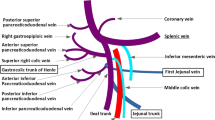Abstract
Purpose
This study was designed to evaluate the clinical outcome of the visible coil during endoscopy after transcatheter arterial embolization (TAE) for gastrointestinal bleeding.
Methods
We retrospectively reviewed the medical records of 1415 patients who underwent TAE for gastrointestinal bleeding between 2001 and 2017. Among these 1415 patients, 70 underwent TAE using coils and consecutive follow-up endoscopy. Finally, 11 patients with an extravascular coil seen on follow-up endoscopic examination were included in this study. We evaluated the underlying cause of the gastrointestinal bleeding, the technical and clinical success rates, the type of extravascular coil after TAE, and the clinical outcomes of the extravascular coil seen on follow-up endoscopic examination.
Results
Of the 11 patients, the most common underlying cause of gastrointestinal bleeding was a duodenal ulcer (n = 7). On angiography, the bleeding artery was most commonly found in the gastroduodenal artery (n = 6). The technical success and clinical success rates of TAE were 100% and 90.9%, respectively. The type of extravascular coil found on endoscopic examination was classified by submucosal migration (n = 6) and protrusion (n = 5). On second-look endoscopic evaluation, 10 of 11 (90.9%) patients showed healing ulceration. On the final-look endoscopic evaluation, healing ulceration without further bleeding was seen in one (9.1%) patient and scar formation was seen in ten (90.9%) patients.
Conclusions
Extravascular coil after TAE for gastrointestinal bleeding is rare, and the most common underlying cause is duodenal ulcer bleeding. The extravascular coils eventually show a healing process with adequate treatment of underlying bowel pathologies.


Similar content being viewed by others
References
Yap FY, Omene BO, Patel MN, et al. Transcatheter embolotherapy for gastrointestinal bleeding: a single center review of safety, efficacy, and clinical outcomes. Dig Dis Sci. 2013;58:1976–84.
Burkun A, Bardou M, Marshal JK. Consensus recommendations for managing patients with nonvariceal upper gastrointestinal bleeding. Ann Intern Med. 2003;139:843–57.
Sarin A, Monga N, Adams PC. Time to endoscopy and outcomes in upper gastrointestinal bleedings. Can J Gastroenterol. 2009;23:489–93.
Qvist P, Arnesen KE, Jacobsen CD, et al. Endoscopic treatment and restrictive surgical policy in the management of peptic ulcer bleeding. Five years’ experience in a central hospital. Scand J Gastroenterol. 1994;29:569–76.
Loffroy R, Guiu B. Role of transcatheter arterial embolization for massive bleeding from gastroduodenal ulcers. World J Gastroenterol. 2009;15:5889–97.
Aina R, Oliva VL, Therasse E, et al. Arterial embolotherapy for upper gastrointestinal hemorrhage: outcome assessment. J Vasc Interv Radiol. 2001;12:195–200.
Dinter DJ, Rexin M, Kaehler G, et al. Fatal coil migration into the stomach 10 years after endovascular celiac aneurysm repair. J Vasc Interv Radiol. 2007;18:117–20.
Takahashi T, Shimada K, Kobayashi N, et al. Migration of steel-wire coils into the stomach after transcatheter arterial embolization for a bleeding splenic artery pseudoaneurysm: report of a case. Surg Today. 2001;31:458–62.
Shah NA, Akingboye A, Haldipur N, et al. Embolization coils migrating and being passed per rectum after embolization of a splenic artery pseudoaneurysm, “the migrating coil”: a case report. Cardiovasc Intervent Radiol. 2007;30:1259–62.
Han YM, Lee JY, Choi IJ, et al. Endoscopic removal of a migrated coil after embolization of a splenic pseudoaneurysm: a case report. Clin Endosc. 2014;47:183–7.
Chosa K, Naito A, Awai K. Extravascular submucosal coil migration after transcatheter arterial embolization for a massively bleeding duodenal ulcer. Cardiovasc Intervent Radiol. 2011;34:1098–101.
Kuhara A, Koganemaru M, Ishikawa H, et al. Late-occurring coil migration into the duodenum. BMJ Case Rep. 2013;2013:bcr2012007759.
Skipworth JR, Morkane C, Raptis DA, et al. Coil migration–a rare complication of endovascular exclusion of visceral artery pseudoaneurysms and aneurysms. Ann R Coll Surg Engl. 2011;93:19–23.
Vale Rodrigues R, Saiote J, Bilhim T. Endoscopic view of embolization coil in a duodenal ulcer. GE Port J Gastroenterol. 2015;23:226–7.
Shen YC, Liao CH, Shen TC, et al. Coil migration following transcatheter arterial embolization. Intern Med. 2014;53:519–20.
Singh G, Denyer M, Patel JV. Endoscopic visualization of embolization coil in a duodenal ulcer. Gastrointest Endosc. 2008;67:351–2.
Vardar R, Ozemiz O, Parildar M. Endoscopic view of intravascular platinum coil after embolization of bleeding duodenal ulcer: report of two cases. Endoscopy. 2009;41:125–6.
Filippiadis DK, Binkert C, Pellerin O, et al. Cirse quality assurance document and standards for classification of complications: the cirse classification system. Cardiovasc Intervent Radiol. 2017;40:1141–6.
Shin JH. Recent update of embolization of upper gastrointestinal tract bleeding. Korean J Radiol. 2012;13:31–9.
Author information
Authors and Affiliations
Corresponding author
Ethics declarations
Conflict of interest
The authors declare that they have no conflict of interest.
Informed Consent
This study has obtained IRB approval from our institution and the need for informed consent was waived.
Additional information
Publisher's Note
Springer Nature remains neutral with regard to jurisdictional claims in published maps and institutional affiliations.
Rights and permissions
About this article
Cite this article
Shim, JJ., Chu, H.H., Shin, J.H. et al. Clinical Outcome of the Visible Coil During Endoscopy After Transcatheter Arterial Embolization for Gastrointestinal Bleeding. Cardiovasc Intervent Radiol 42, 1537–1544 (2019). https://doi.org/10.1007/s00270-019-02258-x
Received:
Accepted:
Published:
Issue Date:
DOI: https://doi.org/10.1007/s00270-019-02258-x




